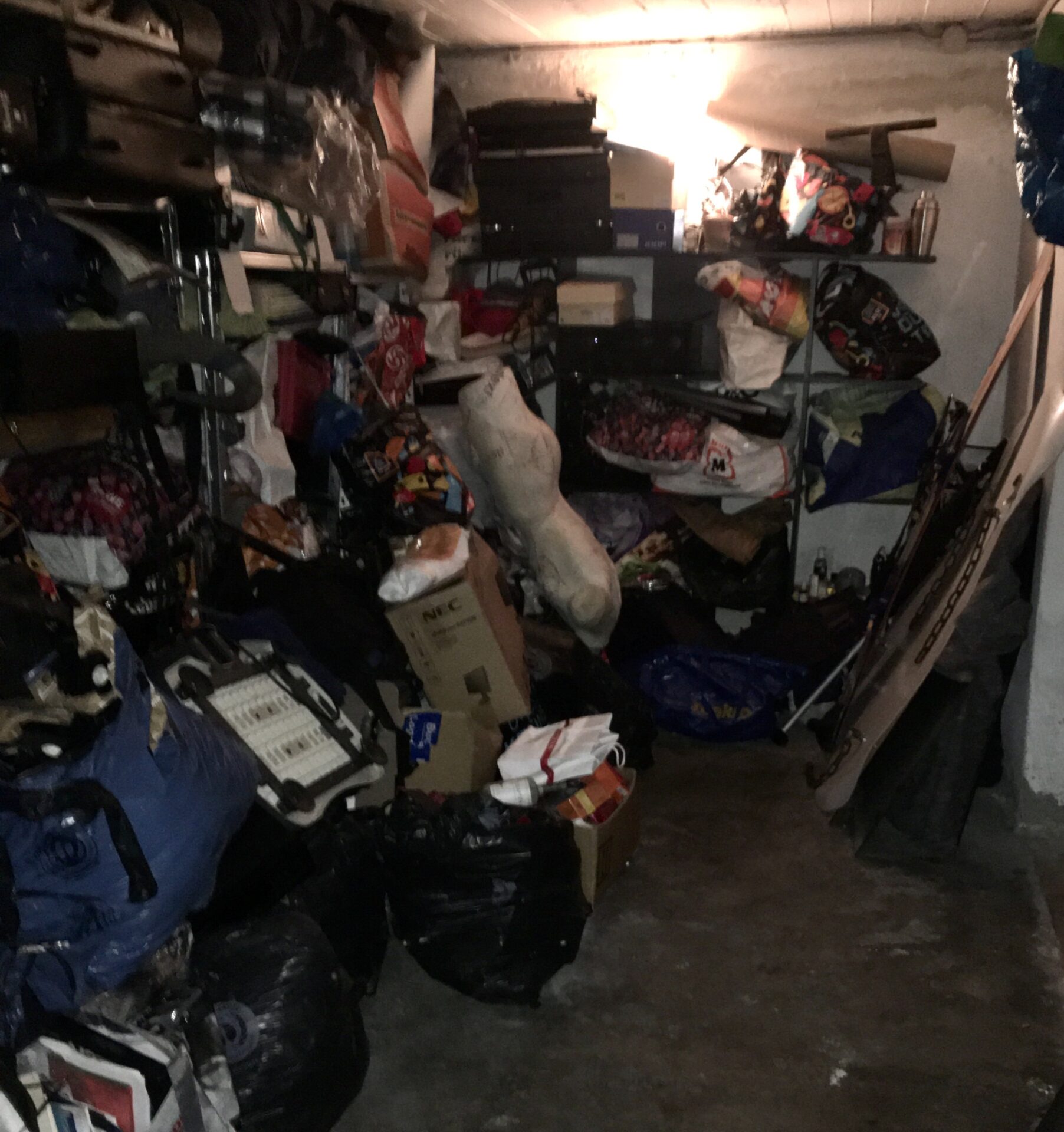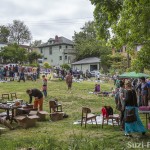Chances are, if you own a home, you have a garage. And if you’ve lived in that home for even a little while (one day, to be exact), that garage is becoming increasingly crowded and has less and less space for serving the purpose for which it was originally ordained: parking your car. What’s in there instead? Ample reminders, one could say, of our fallen nature as creatures of dust, who not only have come of dust and to dust shall return, but are also the hoarders of substances of dust, who too to dust shall return one day—although given the longevity of modern plastics and glass, perhaps that day will come long after our own bodies have successfully made that fateful, inexorable transformation.
My husband has reminisced a few times about his family’s next-door elderly neighbor when he was growing up in Bangor, Maine. This neighbor had a very full garage. How full? Each day, he would open it to carefully inspect his possessions within, which filled the garage from top to bottom, and from its invisible farthest depths to the outermost edge. The door could roll down—but barely.
Anytime he found a new treasure—another neighbor’s discarded broken chair, some table legs, electronics set out on the curb, cushions that have lost all trace of fluffiness within, faded and chipped knick-knacks of unknown provenance, gardening implements retired from duty by reason of rust and excessive wear—he would open his garage door, carefully inspect the tightly compacted treasures within, locate a gap sufficient to house the new addition, and gingerly stuff it in, before rolling the garage door back down, satisfied with the labor completed well. Sometimes, though, he would simply unroll the door and stand in front of it, looking upon the impermeable wall of stuff with a tender lover’s longing gaze.
This past summer, we moved from our long-time home in Georgia half-way across the country. That process forced us to clean out our own garage for the first time. In the process, we discarded two lawnmowers (broken beyond repair), a veritable graveyard of broken toys that included a small army of partially deflated balls of all shapes, sizes, and colors, multiple old bookcases that couldn’t quite cut it in our family’s austere regime of book collecting and caved prematurely, and countless cans of varied colors of wall and deck paints going back decades—many preceding our ownership of that home and garage.
How do you tell the story of someone’s life, the tale of the fleshly sojourn here of a creature with an immortal soul, yet anchored in bodily and physical creation? Sometimes, as we examine the story of our life or someone else’s, a garage can be a good place to start. It is, after all, a strangely liminal place for storing stuff, these artifacts of our existence. It is neither the haven of happy habitation in harmony with humanity, nor the place of damnation for all ruined artifacts that is the landfill. And yet, for an artifact relegated to this unhappy in-between place, what are the odds of being adopted again for use in the happy everyday? The answer, perhaps, varies depending on the garage’s owner. For, indeed, some use the garage for storing things that are genuinely useful, which may yet see the light of day—and, more important, the inside of the house—one of these days. But others, like my husband’s childhood neighbor, perhaps transform the garage into a holding place for things already dead, objects that one cannot bring himself to let go, set free.
Archaeological debris of the past reminds us that these artifacts of material culture have always been solid footprints of human existence, offering secrets long forgotten of lives we otherwise would never have known at all. Like those document dumps from the Egyptian desert sands that are still yielding tales of deals gone right or wrong in the days of the Ptolemies, police reports of stolen cattle, contracts signed and fulfilled or broken, or that ancient Egyptian equivalent of a kegger for which a group of village men once wrote to a nearby town seeking to hire a troupe of dancers. But written records can be few and far between today in our garages, packed as they are with items inadvertently or purposefully lost and hoping to be found—or not. Thankfully, no writing is necessary to tell some stories, at least, about us and our past. Artifacts seem to speak less articulately than we ourselves, but they may yet yield many secrets. Or, rather, theories of secrets.
An abundance of artifacts can still present puzzles, I am reminded as I think of the many puzzling finds from antiquity—like the middle-aged man who was buried in quite an unusual fashion on the island of Euboea sometime ca. 1,000 BCE. We do not know who he was, and yet, his burial in a building—not quite a home, not quite a storage shed, a garage of sorts—tells a powerful story about his life and dreams. He was cremated, and his ashes were placed in a much older bronze bowl. Weapons were placed next to him. Buried nearby, but not cremated, were his companions on his journey out of this life: four horses, ceremonially slaughtered, and a young woman, decked out with gold jewelry.
Ever since this burial was discovered, scholars have been asking questions about it. Who is this man? Why was he buried in such an unusual matter? Who is the woman buried with him? Was she connected to him in life? Did she die a natural death, or was she killed as part of his funeral proceedings in order to accompany him in death? What’s the deal with the horses anyway? The whole thing has powerful echoes of Homer, so perhaps he had heard the Homeric epics?
At least, it seems, that man had lived and died with the belief that he could take these things with him. And so, he was buried in a sort of garage, right along with what had mattered to him the most. As we consider our own over-consumerism today and the stuff that, as a result, overflows many a garage, we say: you can’t take it with you. And yet we behave as though we could—right up until the moment when, too late, we realize that we cannot.
Why did the previous owner of our new home, who had lived here for fifty years, leave a massive ball of string on a shelf in the garage, otherwise bare when we moved in? But then, someone else could wonder, why have we filled the garage with mysterious parts of furniture, some bearing the distinctive traces of tiny teeth? I can explain, but maybe it is preferable that I do not. It would be better to keep this great mystery concealed, for the glory of the secret is so much more beautiful in its puzzle than in mundane revelation.
But then maybe we ourselves are like that garage attached to our home—physical and outwardly accessible manifestations of something that can be visible to all who dare look in, and yet undeniably mysterious, messy, and difficult to interpret correctly for certain. Why did my husband store orphaned socks for years in a tub in the deepest recesses of his bachelor apartment’s closet—back in those days, before he had a garage to use for such hoards? Or why is cleaning out a home—a garage, the closets, the attic—so difficult for many of us, no matter the stage of life at which we do it? Why can’t I throw out or give away that bright yellow sundress that I last wore well over a decade ago, and which is unlikely to ever fit again my decidedly maternal and middle-aged body? Nostalgia, it seems, is an integral part of our human personhood, connected perhaps to all the sinful longings we have developed in our disordered fallen nature. I can make fun of my children’s predilection for comfort objects—that stuffed doll that is falling apart, but without which my five-year-old still cannot fall asleep—but am I any better myself, with all of the sentimental objects to which I cling, move after move?
No home but the Garden was there originally for man, once upon a very long time ago. No garage either was part of life before expulsion from Eden. Stuff—all the things we accumulate and feel deep down that we need—became, rather, part of our nature post-fall. Clothes to cover our bodies, granaries to store food, weapons caches to hoard means of protection, and of course, garages to house all that stuff that we cannot quite figure out what to do with—and yet keep it we must.
And so it continues. So much baggage gets stored within, for decades even without retrieval—until one day it bobs to the surface again, stubbornly requesting to be seen, acknowledged, held in hand, loved.
Image via Wikimedia





